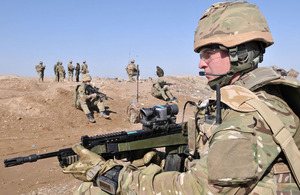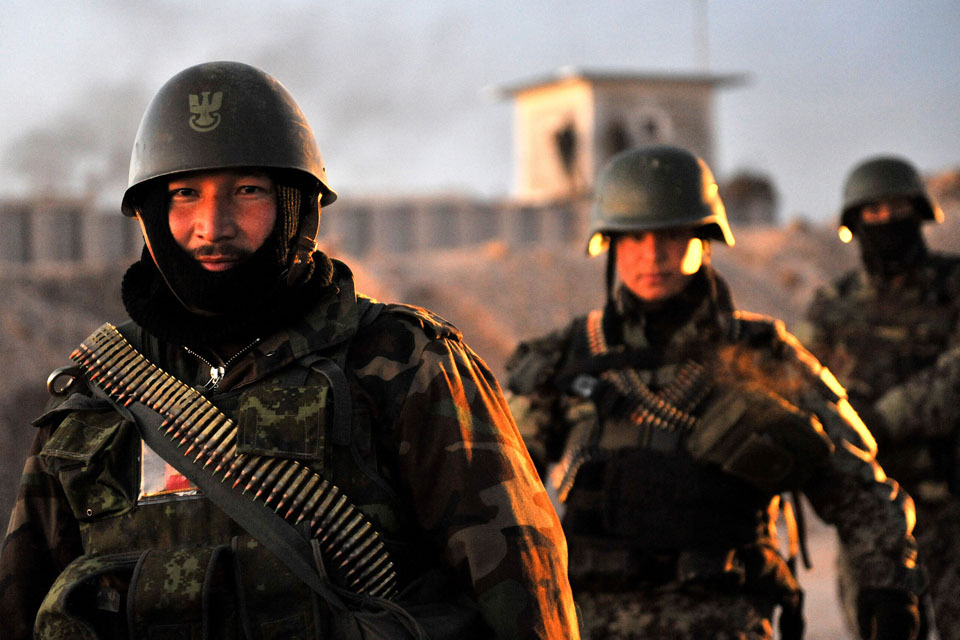Prime Minister announces reduction in UK troop numbers in Afghanistan
UK force levels in Afghanistan are to reduce to around 5,200 by the end of 2013, the Prime Minister announced today.

Members of the UK armed forces on patrol in Afghanistan (stock image)
The Prime Minister told Parliament that UK forces would shift from mentoring Afghan troops at battalion level to brigade level next year. This reflects the progress made in Helmand and the increasing ability and confidence of the Afghan National Security Forces (ANSF) to lead security operations.
The drawdown, agreed by the National Security Council this week, is in line and consistent with both UK military advice and the North Atlantic Treaty Organization strategy agreed at the Lisbon Summit in 2010, under which International Security Assistance Force (ISAF) forces continue to operate across the country.
UK forces will end combat operations by the end of 2014. It is part of transition to an enduring commitment to Afghanistan.
Today’s announcement comes as the previously announced reduction of UK force levels from 9,500 to 9,000 is being achieved with service personnel due to arrive home in time for Christmas.
Detailed work on how force levels will reduce in 2013 is ongoing and will be conducted in line with operational requirements and the transition process which remains on track.
But as the Afghan forces increasingly take the lead, UK combat operations will give way to an increasing focus on training and advising. By the end of 2013, it is expected that UK forces will not routinely need to mentor Afghan forces below brigade level, allowing the reduction in numbers.
Defence Secretary Philip Hammond said:
The real progress being made on the ground in Helmand province will allow us, on current planning, to reduce British troops to around 5,200 by the end of 2013. This is a direct result of the success of the Afghan National Security Forces in assuming a lead role in delivering security for the Afghan people.
The phased process of transition of security responsibility agreed at the Lisbon Summit is well advanced and on track.
We have consistently said that there will not be a cliff-edge reduction in troop numbers at the end of 2014. This gradual drawdown is firmly in line with the planning of our ISAF partners and the advice of military commanders.
UK forces will continue to operate alongside their Afghan counterparts, albeit in lower numbers, until our combat operations cease at the end of 2014.
There remain huge challenges ahead for the Afghan people. Our combat mission is drawing to a close, but our commitment to the Afghan people is long term.

Members of the Afghan National Army take part in an operation in Helmand province (stock image) [Picture: Sergeant Steve Blake RLC, Crown Copyright/MOD 2012]
The Chief of the Defence Staff, General Sir David Richards, said:
The Afghan National Army and Police have greatly improved in the past years. Their capability has increased so that today they enjoy the trust of some 84 percent of the population.
As they develop, and in agreement with the ANSF, the efforts of our Armed Forces will continue to shift from a combat role to one that focuses on training, advice and assistance. That will allow us to make appropriate and measured reductions in our force levels in line with the ISAF plan and our Chicago commitments.
These drawdown plans are based on military advice and following discussion with General Allen [Commander ISAF Forces]. I am confident that the progress we have seen in Helmand and across Afghanistan can be maintained and that we can complete the tasks we have been set.
To be in the position where we are now able to commit to reducing UK force levels to around 5,200 by the end of next year is testament to the professionalism and courage of those personnel who have served, and continue to serve, in Afghanistan.
We must remember that the UK’s commitment to the operation in Afghanistan will continue beyond the end of 2014 as DFID [Department for International Development] and the Foreign Office continue to build the government and nation while the UK’s pledge to support the ANSF, including training the military’s officers, will be ongoing.
Significant progress in Afghanistan continues with 75% of the Afghan population now being secured by the ANSF and at least 80% of all patrols being ANSF-led.
Of 80 UK bases at the start of the HERRICK 16 deployment this April, only 32 remain active with the others having been handed over to Afghan forces or closed. Afghan National Army numbers in Helmand province now stand at about 18,000.